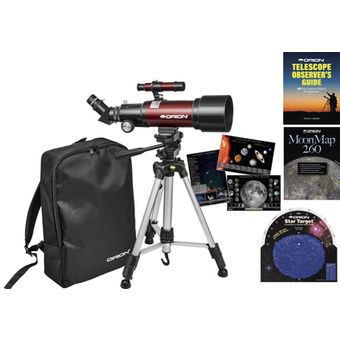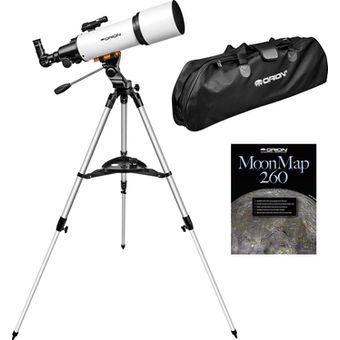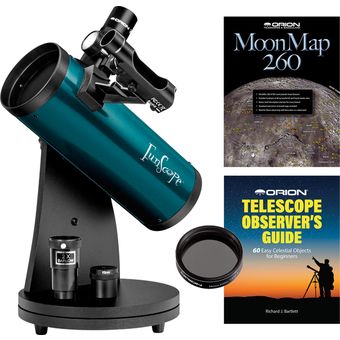If you enjoy exploring and travel or are simply into outdoor activities, such as camping and hiking, then you might have looked at some of the portable telescopes on the market. After all, the stars can be amazing when you’re far from the bright lights of a town or city – and there’s a lot to see during the daytime too. The good news is that a good quality scope won’t break the bank and, if you’re looking to take it with you, it won’t break your back either.
See also:
The Best Portable Telescopes – for Hiking and Camping
When you’re hiking, the last thing you need is the inconvenience of having to carry around a telescope. But wouldn’t it be great if there were portable telescopes specifically designed to provide good quality views and be small, lightweight and affordable?
Fortunately, there are a number of options available to you. Probably the best choice for terrestrial observation (such as birding or admiring the scenery) is the Orion GoScope III 70mm Refractor Travel Telescope.
1. Orion GoScope III 70mm Refractor Travel Telescope

Image Credit: Orion (Used with Permission)
This is a traditional refractor telescope, and while these types of telescope can often have a long tube (potentially making them a little unwieldy) that’s not the case with the GoScope III.
The tube itself is just under 17 inches long and is easily and safely stored in the provided backpack. There’s also room in the backpack for the tripod and the supplied accessories.
The lightweight aluminum tripod extends to a maximum height of 43 inches and collapses to just over 12 inches in length. Of the two supplied eyepieces, one has a focal length of 20mm while the other is 9mm, providing magnifications of 20x and 44x, respectively.
Right-Side-Up Views and Easy Assembly
Orion also provides a 45 degree diagonal with the telescope, which serves two purposes: firstly, it makes viewing more comfortable as you’re able to look through the eyepiece at an angle that’s perpendicular to the tube (rather than contorting yourself to look directly through the tube itself) and, secondly, it corrects the image so that it appears “right side up.”
Without the diagonal the view appears inverted. This isn’t necessarily a problem if you’re using it to observe the night sky, but it’s a different story when it comes to observing terrestrial targets, such as distant scenery.
Another plus is the ease with which it can be assembled and used. The telescope attaches to the tripod like a camera and can be moved horizontally and vertically by way of a handle, for a simple, hassle-free experience that anyone in the family can enjoy.
If you want to turn the telescope skyward, you’ll find it can provide fine views of the planets, stars and deep-sky objects. There’s also a Moon map included with the telescope, so both you and your kids can discover the Moon like true space explorers.
When you’re done, you can simply store everything in the backpack, but if you think all this equipment will weigh you down, think again. With a weight of just 4.3 pounds, you’ll barely notice it, and the backpack itself is small enough to be taken onto a plane as hand luggage and stored in an overhead bin or under the seat in front of you. This alone makes it stand out from the other portable telescopes on the market.
2. Zhumell 60mm Portable Refractor Telescope
Another option for hikers is the Zhumell 60mm Portable Refractor Telescope. This is similar to the Orion telescope but is slightly cheaper and has a few key differences. For starters, its lens (called the aperture) is 10 mm less than Orion’s. This determines how much light the telescope can gather; the larger the aperture, the more light it can gather and, as a result, the fainter the object and the more detail you can see.
Realistically, this isn’t really an issue if you intend to use the telescope to observe terrestrial targets, but it may have some limitations when it comes to astronomy. For example, it’s not the best tool for observing galaxies, but the Moon, planets, stars and star clusters will be fine.
It also has a shorter focal length. This is the distance that light takes to travel from the aperture to the eyepiece. This is important because it determines the magnification of the eyepiece you’re using.
The Orion GoScope III has a focal length of 400mm, whereas the Zhumell portable refractor has a focal length of 360mm. Again, it’s not a deal-breaker, but it’s something to bear in mind.
Triple the Magnification with a 3x Barlow
On the plus side, it comes with two eyepieces (a 20mm and 8mm, for a magnification of 18x and 45x, respectively) and a 3x Barlow lens. This handy accessory will triple the magnification of any eyepiece attached to it, making magnifications of 54x and 135x available to you when used with the supplied eyepieces.
Like the Orion GoScope, there’s a diagonal included that will allow you to properly observe terrestrial targets and, as an added bonus, you’ll also find a smartphone adapter. This gives you the opportunity to take images of whatever it is you’re observing through the telescope. This is great for the Moon and anything you choose to observe during the day, but be aware that it won’t work so well on stars or fainter deep-sky objects.
Lastly, instead of a backpack you’ll get a carry-bag capable of safely holding the telescope and all its accessories, and with a total weight of just 3.5 pounds, this Zhumell is another option that stands out from the other portable telescopes you may be considering.
3. Celestron 80mm Travel Scope Refractor
Our final pick of the portable refractors is the Celestron 80mm Travel Scope Refractor. This has the largest aperture of the scopes we’ve considered so far (80mm) but it also comes with the highest price tag. That said, it has a focal length of 400mm and comes with similar accessories to both the Orion and the Zhumell: a diagonal for terrestrial targets, a smartphone adapter, a backpack and two eyepieces (20mm and 10mm) for magnifications of 20x and 40x.
There’s no Barlow lens, but Celestron have included a free digital download of the popular Starry Night planetarium software for your Mac or PC, and when it’s all stowed away in the supplied backpack, it weighs just 4.5 pounds.
The Best Portable Telescopes – for Stargazing
Of the options we’ve looked at so far, the travel refractors are best suited for hikers, campers and travelers who are probably going to use their telescope more for daytime terrestrial observations. They can be used for astronomy too, but if you truly want to enjoy exploring the universe, it’s best to have a little more power available to you.
There are two great options available to you if you’ll be looking up at the night sky first and then across the daytime landscape second.
1. Orion StarBlast 102mm Altazimuth Travel Refractor Telescope

Image Credit: Orion (Used with Permission)
Firstly, there’s the Orion StarBlast 102mm Altazimuth Travel Refractor Telescope. This boasts an aperture of 102mm and a focal length of 600mm, so you’ll have the means to see fainter objects at a higher magnification than any of the previous options.
Like the other options, it comes with two eyepieces, a 25mm and a 10mm, for magnifications of 60x and 24x, both of which are great for observing the Moon, planets and especially star clusters.
It also comes with a diagonal and Orion’s Moon Map so you can enjoy observing nearby terrestrial targets and also our nearest celestial neighbor. Lastly, it comes complete with its own carry case for easy transportation. However, there are two potential pitfalls here; it weighs 10.6 pounds, making this the heaviest of our picks so far, and it’s also the most expensive.
2. Meade Infinity 90mm Portable Refracting Astronomy Telescope
A second option is an Infinity 90mm Aperture Portable Refracting Astronomy Telescope from Meade. It has a smaller aperture than the Orion StarBlast (90mm) but it also has a focal length of 600mm, so you can still get the magnification you need to observe deep-sky objects.
In terms of accessories, it has the best options of any of the scopes we’ve reviewed here. Not only will you get a diagonal for daytime terrestrial observations, but also three eyepieces and a 2x Barlow.
The eyepieces have focal lengths of 26mm, 9mm and 6.3mm, which can produce magnifications of 23x, 67x and 95x respectively. Use the 2x Barlow and you’ll also have magnifications of 46x, 134x and 190x – a perfect range for observing every conceivable celestial target from the Moon and planets to faint nebulae and distant galaxies.
The downside is that it weighs 11.2 pounds and there’s no case provided, but finding a holdall shouldn’t be too much of a problem.
The Best Portable Telescopes – for Families
Many kids love the adventure of traveling and camping, so what better way to enhance their enjoyment (and potentially learn something!) than to take a telescope along with you?
Traveling with a telescope is one thing, but when it comes to kids, you’ve also got to consider how easy the scope is to use. That’s why our two selections are small, inexpensive and lightweight but still have the power you need to wow the kids.
1. Celestron FirstScope
Both Orion and Celestron produce their own version of a starter scope for kids that can easily be transported in a car, truck or RV. In the end, it might simply come down to how much you’re willing to spend.
Celestron produce the FirstScope Reflector Telescope while Orion has the FunScope 76mm TableTop Reflector Telescope. Both have an aperture of 76mm, a focal length of 300mm and weigh about four pounds. Both come with two eyepieces; a 20mm and a 6mm for magnifications of 15x and 50x.
(For more on this one, see our full review of the Celestron FirstScope.)

Image Credit: Richard Bartlett / TelescopeGuide.org
2. Orion FunScope 76mm Reflector Telescope (“Moon Kit” option)

Image Credit: Orion (Used with Permission)
On the face of it, it might seem as though the Orion FunScope is the better choice for astronomy, but if there’s a catch, it’s that it costs a little more than the Celestron FirstScope. Arguably, the extra outlay is a sound investment if you intend to make regular use of the scope.

Image Credit: Brian Taylor / TelescopeGuide.org
Accessories? Choose Celestron FirstScope For Software or Orion FunScope For Hardware
The differences are in the accessories. With the Celestron you’ll get a code for a digital download of Starry Night Pro, just as with their Travel Scope Refractor. (Incidentally, Celestron have also teamed up with Simulation Curriculum Corp to rebrand their popular SkySafari app as their own SkyPortal app. You can download it for free from either Google Play or the Apple Store.)
Orion’s FunScope “Moon Kit” package, however, provide you with a red dot finderscope, observer’s guide, lunar filter, 2x Barlow and a Moon Map, all of which are probably more practical out in the field (perhaps literally!) – especially given that astronomy smartphone apps can be downloaded for free, thereby potentially negating the need for the Starry Night software.
(NB – you can also get the FunScope without the filter and observer’s guide at a slightly lower price. Or you can opt instead for the “kids kit” from Orion that includes a planisphere.)
The Best Computerized Portable Telescopes for Beginners
On any given night, there could be hundreds of potential targets for you to observe in the sky. Everything from the Moon and planets to star clusters, nebulae and galaxies are within your reach. But what if you don’t know where to start?
Maybe you’re not yet familiar with the stars and constellations and everything the universe has to offer. That’s where a computerized “GoTo” scope can help.
A GoTo scope has a built-in database of thousands of objects you can potentially see. When you reach your destination, you only need to set your location, align the telescope with a few bright stars (don’t worry, you won’t need to know which ones) and then the telescope does the rest.
You can either select a target from its database or have it suggest targets for you. It’ll then “go to” that object in the sky.
Celestron 114LCM Computerized Newtonian Telescope
Probably the best value for money is Celestron’s 114LCM Computerized Newtonian Telescope. Specifically designed for beginners, it boasts an aperture of 114mm and an impressive focal length of 1000mm. This combination provides the light-gathering power you’ll need to see fainter targets, plus the ability to provide the higher magnifications needed to study the planets and smaller targets.
There are two potential downsides. The first is that you’ll only get two eyepieces (a 25mm and a 9mm for magnifications of 40x and 111x) but a 2x Barlow and other accessories are fairly inexpensive.
The second downside is there’s no carrying case, but the tripod collapses neatly to a length of 29 inches (including the mount) and the telescope tube is only 18 inches long. The tube is also quickly detached from the mount and tripod, making it possible to easily transport the telescope and then assemble it again once you reach your destination.
Something else to bear in mind is that the telescope has a total weight of 13.2 pounds, which makes it a little impractical to carry and necessitates a vehicle for transportation.
Final Thoughts | Best Portable Telescopes
Ultimately, the telescope you choose will depend upon your needs and your budget, but each of the telescopes selected here are designed to be both portable and easy for beginners to use. Whichever option you choose, you’ll find that unforgettable adventures don’t just happen when you explore the Earth, but also when you explore the universe in the night skies above you.
(Also, if you liked this article, please share it using the social media buttons below!)About the Author
Richard J. Bartlett: Richard has been featured in Sky & Telescope and Astronomy magazine. He’s written and published a number of astronomy-related books, and we’re super happy to be able to work with him on Telescope Guide articles.Why You Can Trust Our Reviews
At TelescopeGuide.org we're as passionate about astronomy as you are. As such, we take our recommendations seriously and would never recommend anything we wouldn't be willing to buy and use ourselves. When we consider our recommendations, we look at a wide variety of products from a range of manufacturers. We take into account the quality of the product, as well as its durability, ease-of-use, performance, and overall value for money.Whenever we can, we test the products ourselves or, if that's not possible, we consider the opinions and experiences of other astronomers. Lastly, we take all these criteria and make our decision by creating an objective score for each one. In this way, whatever your needs, requirements or budget, you can be sure you're getting the best possible advice before you make your buying decision.
Feature Image Credit: JULIAN74 / iStock









